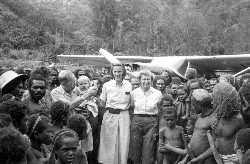
WASP Aviator Betty Greene Became Mission Pioneer
Contact: Nicole Aptekar, 909-851-0326, naptekar@maf.org
MEDIA ADVISORY, March 23 /Christian Newswire/ -- As the first pilot for Mission Aviation Fellowship, Betty Greene became the first woman to fly across the Andes and the first woman to pilot an aircraft in Sudan.
Photo: Greene (center) made the first flight into a rugged region of Papua, Indonesia, to visit missionaries Bill and Grace Cutts. The Monis tribe, which had worked so hard to build the air strip, came out in full force.
But Greene, a member of the Women Airforce Service Pilots (WASP) of World War II, wasn't one to talk about her pioneering achievements. As WASP aviators, Greene and 1,100 other women took on non-combat flying duties that often were hazardous, freeing up male pilots for combat.
She wasn't looking for publicity, and the last thing she wanted to do was brag about any of it. Had it not been for Greene's parents sharing her exploits with the rest of the family, not even her closest kin might have known much about her work.
"I never got the feeling that any of the Greene siblings ever thought anything they did was heroic," said Naraelle Hohensee, Greene's grand-niece who represented her great aunt this month at a Capitol Hill ceremony that honored WASPs with a Congressional Gold Medal.
Betty Greene's older brother Al, who in 1940 sailed with his wife to China as a missionary, is Hohensee's grandfather. Hohensee found that attitude of humble sacrifice common among her great-grandparents' children and the women of their generation receiving the honors.
"I got the feeling it didn't faze the women who actually did it. They didn't realize they were doing anything out of the ordinary," Hohensee said. "They just did what they loved.
"I think Aunt Betty felt the same way. She was doing what she loved and didn't think anything else of it."
Greene died April 10, 1997, of Alzheimer's at her home on Lake Washington near Seattle. She was 77.
Betty Greene's fascination with becoming a pilot began in childhood. A devout Presbyterian who enjoyed ministering in her church's youth group, she also sensed God had called her to use airplanes to further missionary work -- even though at the time, there was no such thing as mission aviation.
While training at Avenger Field in Sweetwater, Texas, for the WASP program, Greene wrote a pair of articles for Christian publications about how flying could advance Christian ministry. Three American military pilots responded by sharing with her their vision for creating the Christian Airmen's Missionary Fellowship.
After word came that WASP would disband in December 1944, Greene moved to California to set up an office for the fledgling group. It eventually connected with combat pilots of like vision in the UK, Australia and New Zealand to become Mission Aviation Fellowship. Greene flew MAF's first flight, which was in partnership with Wycliffe Bible Translators in Mexico.
In addition to Peru and Sudan, Greene piloted MAF aircraft while based in Nigeria and New Guinea.
Hohensee thinks her Aunt Betty would have shared the attitude of the WASP program's 112 pilots who attended the ceremony. "The women are happy to be honored, but they weren't exulting in the honor," Hohensee said. "She probably would have said the real glory was in her mission work.
"For her, WASP was really more of a means to an end: flying experience and to make her way into mission work."
Founded in the U.S. in 1945, MAF (www.maf.org) missionary teams of aviation, communications, technology and education specialists overcome barriers in remote areas, transform lives and build God's Kingdom by enabling the work of more than 1,000 organizations in isolated areas of the world. With its fleet of 58 bush aircraft -- including the new KODIAK -- MAF serves in 31 countries, with an average of 101 flights daily across Africa, Asia, Eurasia and Latin America. MAF pilots transport missionaries, medical personnel, medicines and relief supplies, as well as conduct thousands of emergency medical evacuations in remote areas. MAF also provides telecommunications services, such as satellite Internet access, high-frequency radios, electronic mail and other wireless systems.

